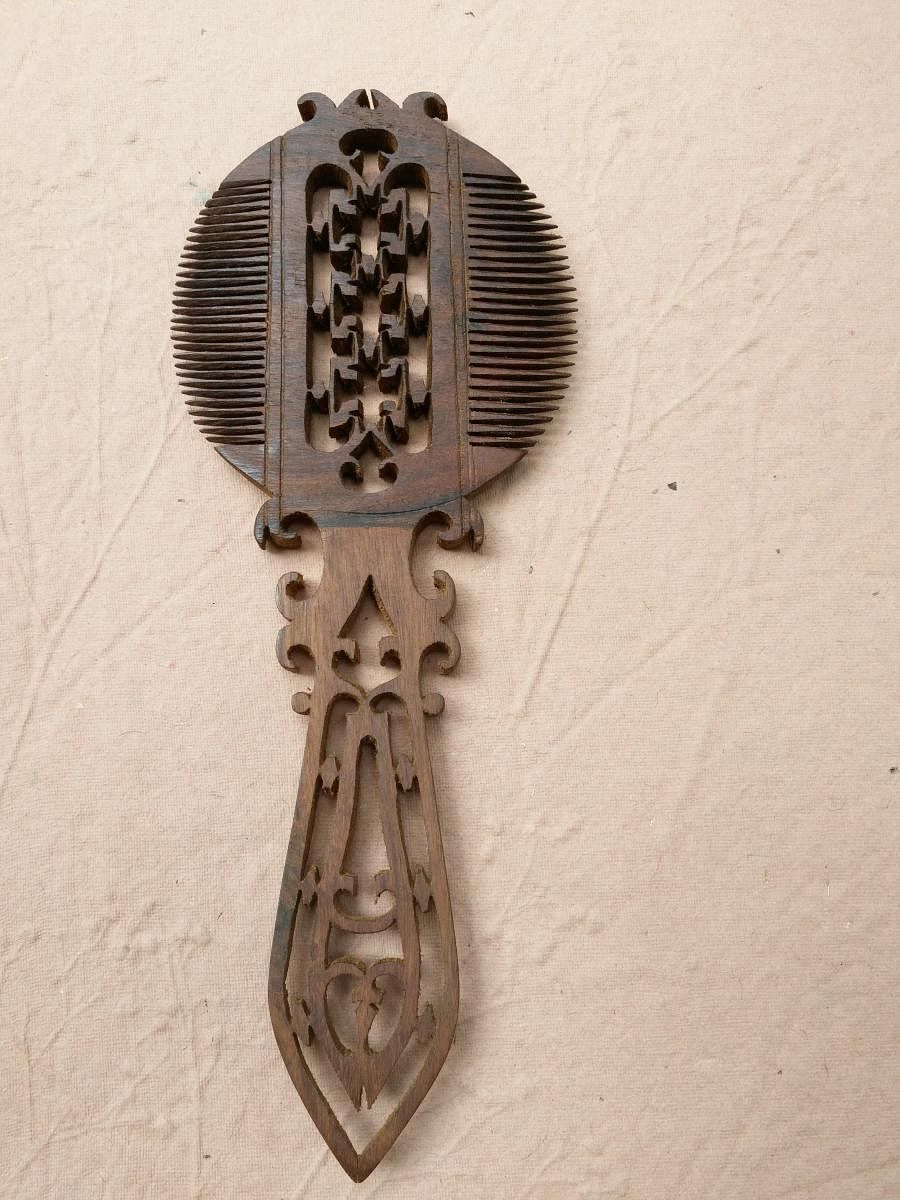
In tucked away Shahdra Sharief, close to Thana Mandi, Rajouri district, Jammu, the vanishing chikri (Himalayan Boxwood) tree is a cause for concern. It’s once easy availability in the forested region had given birth to a cottage industry producing sundry objects of daily use and decor. The straight trunk of the tree and its even-textured, durable wood made it perfect to cut, carve and turn on the lathe while its pine-tone and natural lustre added elegance to the inventory. The most popular item produced was the chikri kangi (comb). Fine-toothed and double-sided, this rectangular comb had a striking jaali (lattice) panel or floral motif in the centre. At times the cutwork was embedded with coloured tin-foil making the comb quite attractive.
“My family has been involved in chikri craft for over a century. My ustad was my grandfather who was respected in the region for his skills. He used to get orders from the Dogra royals, too,” says silver-haired Mohd Akhter of Shahdra Sharief. “We were renowned in making teil kangi or chikri combs that could be filled with hair oil and used as is usually done, ensuring even oiling of the scalp,” he adds with pride. Nowadays, however, chikri wood combs and other items are made strictly on order. “This tree is hardly seen as commercial interests have ensured the prospering of other varieties. The monetary gains from a chikri tree log were low so woodcutters preferred dealing in other timber. My fellow artisans and I have urged the forest department to save the tree and are hoping for its easy availability so that we can continue this age-old craft. These days wooden combs are back in demand but the modern ones lack a creative touch,” sallies the artisan.
It’s this creativity that Akhter mentions which stands out in traditional handmade combs across the regions in India. Since centuries, combs have been made with different material, including, silver, bone, ivory, shell etc. It’s easily-available wood, however, that’s used extensively.
Crafted beauties
Nondescript Nagina, in Bijnour district, Uttar Pradesh, is one place where the tradition of carving combs has remained unbroken for few centuries. Local artisans tentatively date origins back to Mughal Emperor Akbar’s reign, which means the craft is easily over 500 years old. Using sheesham and ebony wood, Nagina’s craftsperson fashion the most exquisite combs used for hair and beard. The carving has distinct Mughal patterns and the artisans’ dexterity particularly stands out in such combs that showcase a different pattern on both sides. Combs of myriad shapes and sizes are made and quite charmingly a lot of these are produced as male-female or raja-rani pairs. In these, the raja kangi has teeth only on one side while the rani kangi has double-sided teeth.
Across the terrain, besides their ornamental value, the major work of the comb was to trap, well, lice and remove them from the hair. “All girls and women kept their hair long and lice was always a bother. So we made very fine-toothed combs for that purpose,” says a comb-maker from Tamil Nadu, who I met at a craft fair in Delhi. He showed an adroitly made comb-in-comb, wherein a small, slender fine-teeth comb fits like a glove into the shoulder of the bigger comb. All I can do is bow to the skill of the unnamed, unsung Indian craftsperson, who is unequivocally preserving a precious, albeit, fading legacy.
A token of love
It’s among the indigenous tribes of India, speckled all over the country — particularly in the entire north-east and the central belt covering the states of Odisha, Chhattisgarh, Jharkhand, Madhya Pradesh and Gujarat — that combs take a whole new meaning. Besides their functional value, they signify tribe, kinship and in Bastar... a token of love.
During my trip to Bastar to witness the culmination of its 75-day Dusshera celebrations, which brings the tribes of the region to Jagdalpur, it was not uncommon to find unmarried girls with a number of combs in their heavily-oiled, tied-up hair and the married one with a single comb. Till a few years back, these would have been fancily made wooden combs but I usually saw them sport different coloured plastic ones. I was told, customarily, suitors present wooden combs that they have carved themselves to a girl.
She happily wears all combs presented to her and finally keeps only one given by the boy of her choice. That is a message to the boy that’s he’s accepted and after marriage the girl always sports that comb. Simple yet significant. A custom, much like the comb itself.